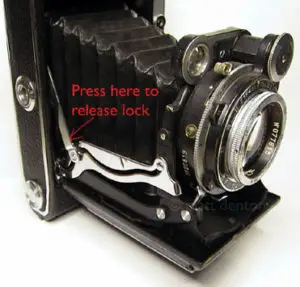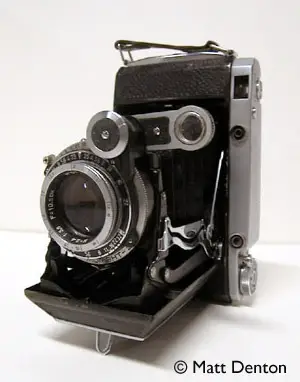- Produced 1955-59 (1958) KMZ, Krasnogorsk (Moscow), USSR
- Film type 120 rollfilm
- Picture size 6cm x 9cm (6×6 with mask)
- Weight 30.6oz (867.5g) without mask
- Lens Industar-24 105mm, f3.5-f32 (4 elements, 3 groups)
- Focal range 1.5m to infinity
- Shutter Moment-24S
- Shutter speeds B, 1-1/250
- Viewfinder COUPLED rangefinder (oooooooh!)
- Exposure meter none
- X-sync
- Self-timer
Overview
The mighty KMZ made this brilliant ‘copy’ (some say improvement) of the famous Zeiss Ikon Ikonta C. Sharp large and lovely coated Tessar-style Industar-24 lens in a strong Moment-24S (S for Sync) shutter, with flash sync and a self-timer. It’s large for a 120 format folder, feels more like the Kiev 4 than a Zeiss Nettar in the hands. Speaking of Zeiss, this example has the infamous ‘Zeiss bumps’ where the old brass rivets have popped up bumps in the leather. That should tell you something about how closely the Russians liked to copy the German classics. More often, though, they added their own design innovations along the way like the geared focusing on the Lubitel, originally a copy of the Voigtlander brilliant. I don’t have an Ikonta but here’s someone’s notes (about halfway down the page) on how this is an improvement. Note that a few people in that discussion talk about using this as a good camera to put in their backpacks while hiking/biking. I personally would find it too large and heavy for that, it weighs more than a K1000 with a 50mm SMC lens attached, I’d take that instead or better yet a little rangefinder like the C35, but that’s just me. This is not a snapshot camera, it’s a serious high-quality take-your-time shooter.
The rangefinder is coupled (yes, oh yes) with a seemingly simple swingout standoff lens that aligns with the rangefinder window. It seems to utilize rotating lenses or prisms inside it to give the split image, I’m not really sure how it works but it does. There is a separate viewfinder window whose framing format changes with a simple switch on top of the camera (you hold it lengthwise) for square or long format. In fact, this switch appears to do nothing more than change a frame in the viewfinder – to change film formats you have to insert / remove a metal mask in the back of the camera as in the (much smaller) dual-format Agfa Plenax and others. Also inside the removable back door of the camera is a simple lever for format-switching that blocks the slider for the red window of the format you didn’t select. (That makes sense I swear.)
Other notes: the shutter release button is on the left side for some reason (as on the aforementioned Nettar). Where you’d expect it to be is really the bellows release button. There is a double-exposure prevention similar to but not as complicated as on the Balda Baldix, though no auto counter. Self-timer is a little button that when moved aside allows you to cock the shutter farther to engage the timer.
Repairs
Bellows is sound, lens is clear, shutter strong like bull. The rest cleaned up very nicely, I did see that part of the mechanical linkage for the shutter release mechanism had popped out of alignment, and that was a simple matter to put the pin back in the hole. This can happen if you press the shutter release while the camera is folded, I did it by accident once on the Baldix. I was originally hesitant to take off the top cap to clean the obvious dirt & dust inside the viewfinder windows but it turned out to be a fairly straightforward task. The round rings surrounding the little windows screw off (you’ll see, they’ve got knurled edges) and then the rest is easy. Not too complicated inside.
Extra Credit
Nice leather case, but adds a lot of weight. So I did the same trick I did with my Kiev 4 case and replaced the rivet with a snap so the top comes off easily. One small note – the rivet is pretty small and close to the case bottom, so there’s not much clearance for the larger snap component. To get around this I trimmed a little slice off the edge of the inside snap base with some tin snips to have a flat side to rest against the bottom of the case. I’m sure you could file it down if you don’t have tin snips.
Tips & Tricks
One, remember to fold up the flipout rangefinder and setting the focus to infinity before closing the camera. Also, though the back door opens with a sliding switch at the handle as per usual, it is not hinged, but pops right off! Actually the removable back thing is true of my other vintage Russian cameras and my large older folders, but for some reason I was surprised enough that at first I thought it was broken.
Speaking of broken, the manual indicates that you must cock the shutter only after changing speeds; e.g., change speeds with the speed ring first, then cock the shutter, or you could damage the shutter. Counter to the advice for most Russian cameras! But I think true of many rim set shutters you see on folding cameras. Also you should only set the self-timer at speeds of 1/100 or slower, faster is not recommended per the manual. I actually don’t recommend ever using the self timer on old mechanical shutters that haven’t been CLA’d, they’re the weak link in the chain that often causes old cameras to jam.
There is a general purpose focus setting as you find on some folders (Agfa, Voigtlander) — the red dot on the focus scale indicates 10 meters and the dot on the f-stop ring indicates 1:11, setting both will give acceptably sharp pictures from 4.5m to infinity.
This camera has a double-exposure prevention lock that is working but a little differently than I expected – how I thought it’s supposed to work is that after cocking and firing, the red dot appears next to the shutter release and resets to silver after you wind on sufficiently. My example seems to work the other way, only firing when the red dot appears and locking when it’s clear. I think maybe the red doesn’t mean ‘stop’ as I’m used to seeing, but ‘ready’ as a gun would. Those Soviets!

I was lucky to get the (apparently elusive) frame mask with this example, though I’m not likely to use it – I have enough 6×6 format cameras, I would use the Baldix before this one if I was going to shoot 6×6. The mask is a thin metal thing that aligns with some bumps and presses into place at the film plane. It is easy to bend when removing, so be careful. You could probably even cut yourself on it, come to think of it. If yours is missing you can get a new replacment at rafcamera.com.
Related Links
- Read all (and I mean all) about it at Alfred’s [wonderful] Camera Page. Includes the history of the model.
- Classic Cameras has the very thing
- Some user-submitted commentary about the Moskva-5 at Medium Format Home
- Rafael of rafcamera.com sells accessories for the Moskva and Lubitel.
